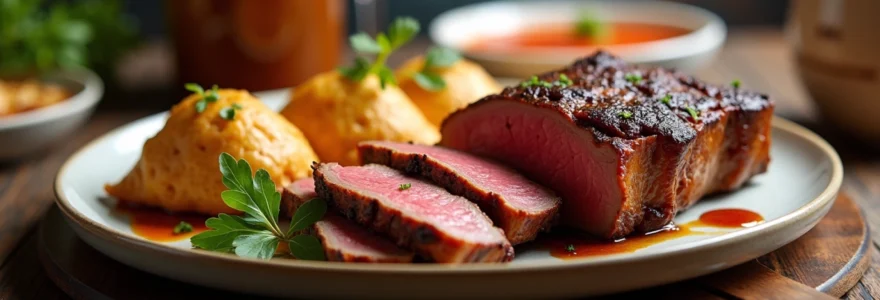Argentina’s culinary landscape is a rich tapestry woven from diverse influences, indigenous ingredients, and time-honoured traditions. From the sizzling parrillas of Buenos Aires to the sun-drenched vineyards of Mendoza, the country’s gastronomic heritage offers a window into its soul. This journey through Argentina’s flavours reveals not just a cuisine, but a way of life deeply rooted in community, craftsmanship, and a profound connection to the land.
Asado mastery: techniques and traditions of argentine barbecue
At the heart of Argentine cuisine lies the asado, a culinary ritual that transcends mere cooking to become a social event. This open-fire grilling technique is more than a method of preparing meat; it’s a celebration of friendship, family, and national identity. The asado brings people together, creating a convivial atmosphere where conversations flow as freely as the wine.
Parrilla grilling: mastering the Open-Flame cooking method
The parrilla, a simple yet ingenious grill, is the centrepiece of any asado. Mastering this cooking method requires patience, skill, and an intimate understanding of fire management. Asadores, the grill masters, carefully control the heat by adjusting the height of the grill or moving coals to create zones of varying temperatures. This nuanced approach allows for the perfect preparation of different cuts of meat, each requiring its own cooking time and technique.
One of the key principles of parrilla grilling is the use of indirect heat . Unlike direct grilling, where meat is placed directly over the flames, the asado method often involves cooking meat slowly over glowing embers. This technique imparts a smoky flavour while ensuring the meat remains juicy and tender.
Regional variations: from patagonian lamb to northern chivito
Argentina’s vast geography gives rise to distinct regional asado traditions. In Patagonia, whole lamb roasted on a cross-shaped spit, known as cordero al palo , is a time-honoured speciality. The crisp mountain air and aromatic wood smoke infuse the meat with unique flavours, creating a dish that epitomises the rugged beauty of the region.
Further north, in provinces like Salta and Jujuy, the chivito (young goat) takes centre stage. Marinated in local herbs and spices, the chivito is slowly cooked over low heat, resulting in meat that’s tender and full of flavour. These regional variations highlight the diversity of Argentina’s culinary landscape and the ingenuity of local cooks in utilising native ingredients.
Essential cuts: exploring vacio, matambre, and entraña
The success of an asado hinges on the quality and variety of meat cuts. While familiar cuts like ribeye and sirloin are popular, true aficionados prize lesser-known cuts that offer unique textures and flavours. The vacio (flank steak), with its rich marbling, is a prized cut that requires skillful grilling to achieve the perfect balance of crispy exterior and juicy interior.
Matambre , a thin cut from the side of the cow, is often stuffed with vegetables and herbs before grilling, creating a flavourful roulade. The entraña (skirt steak) is another favourite, known for its intense beefy flavour and tender texture when cooked correctly.
Chimichurri and beyond: authentic sauces and marinades
No discussion of Argentine barbecue would be complete without mentioning chimichurri, the iconic green sauce that accompanies grilled meats. This vibrant condiment, made from finely chopped parsley, garlic, olive oil, and vinegar, adds a zesty, herbaceous kick to the rich flavours of the asado.
Beyond chimichurri, Argentine cuisine boasts a variety of sauces and marinades that enhance the natural flavours of grilled meats. Salsa criolla, a mixture of finely diced tomatoes, onions, and bell peppers, offers a fresh counterpoint to hearty cuts of beef. For those seeking a spicier option, salsa picante, made with hot chilli peppers, provides a fiery kick to any asado spread.
Malbec and more: navigating argentina’s wine regions
Argentina’s wine industry has experienced a renaissance in recent decades, with its wines gaining international acclaim. While Malbec has become synonymous with Argentine wine, the country’s diverse terroir and innovative winemakers are producing a wide array of exceptional varietals.
Mendoza’s High-Altitude vineyards: terroir and taste profiles
Mendoza, nestled in the foothills of the Andes, is Argentina’s most renowned wine region. The high altitude and arid climate create ideal conditions for viticulture, with intense sunlight during the day and cool nights allowing grapes to develop complex flavours while retaining acidity.
The region’s flagship varietal, Malbec, thrives in this environment, producing wines with deep colour, rich fruit flavours, and velvety tannins. However, Mendoza’s winemakers are also crafting exceptional Cabernet Sauvignon, Chardonnay, and increasingly, high-quality sparkling wines using the traditional method.
Torrontés: the aromatic white wine of salta
In the northern province of Salta, the Torrontés grape variety has found its spiritual home. Grown at some of the highest elevations in the world, Torrontés produces aromatic white wines with intense floral notes and a crisp, dry finish. The Cafayate Valley , with its dramatic landscapes and sun-drenched vineyards, is particularly renowned for its exceptional Torrontés wines.
These wines often display notes of jasmine, rose petals, and citrus fruits, making them an ideal accompaniment to spicy cuisines or as a refreshing aperitif. The unique character of Torrontés showcases Argentina’s ability to produce world-class white wines alongside its famous reds.
Patagonian pinot noir: Cool-Climate viticulture in rio negro
Argentina’s southernmost wine region, Patagonia, is gaining recognition for its cool-climate wines, particularly Pinot Noir. The Rio Negro Valley, with its long, sunny days and cool nights, provides ideal conditions for growing this notoriously finicky grape variety.
Patagonian Pinot Noirs are known for their elegance, bright acidity, and delicate red fruit flavours. These wines often display a mineral character reflective of the region’s rocky soils, adding complexity and depth to the finished product. As climate change impacts traditional wine-growing regions, Patagonia’s cool climate may position it as a future powerhouse in the world of fine wine production.
Mate culture: rituals and social significance
Yerba mate, often simply called mate, is more than just a beverage in Argentina; it’s a cultural institution. This caffeine-rich infusion, made from the leaves of the Ilex paraguariensis plant, plays a central role in social interactions and daily life across the country.
Yerba mate preparation: from gourd selection to cebador techniques
The preparation of mate is a ritual in itself, requiring specific tools and techniques. The traditional vessel, called a mate , is typically made from a hollow gourd, although wooden or metal versions are also common. Selecting and curing a mate gourd is considered an art form, with each vessel developing its own unique character over time.
The role of the cebador , the person responsible for preparing and serving the mate, is crucial to the experience. The cebador carefully fills the gourd with yerba, creates a mound on one side, and adds hot (not boiling) water. The bombilla , a metal straw with a filtered end, is then inserted, and the mate is ready to be shared.
Regional mate variations: tereré in the north, hot mate in the south
While the basic preparation of mate remains consistent throughout Argentina, regional variations reflect local climates and preferences. In the northern provinces, where temperatures can soar, tereré is popular. This cold version of mate is often prepared with fruit juices or herbs, creating a refreshing and invigorating drink.
In the cooler southern regions, hot mate remains the norm, with some areas adding sugar or honey to soften the bitter edge of the yerba. These regional differences highlight the adaptability of mate culture and its deep integration into daily life across diverse climatic zones.
Mate etiquette: unspoken rules of sharing and conversation
Sharing mate is a social ritual governed by unwritten rules that reflect Argentine values of hospitality and community. When offered mate, it’s considered impolite to refuse, even if you don’t intend to drink. The gourd is passed clockwise around the group, with each person drinking the entire contents before passing it back to the cebador for refilling.
Conversations over mate are often intimate and unhurried, creating a space for meaningful connections. It’s common to see groups of friends or colleagues gathered in parks or offices, passing the mate gourd and engaging in animated discussions. This shared ritual fosters a sense of community and belonging that is central to Argentine culture.
Empanadas across argentina: regional recipes and folding techniques
Empanadas, those delectable hand-held pies, are a ubiquitous presence in Argentine cuisine. While the basic concept remains the same across the country – a savoury filling encased in pastry – regional variations in ingredients, preparation methods, and even folding techniques create a diverse landscape of empanada styles.
In the northwest, particularly in Salta and Tucumán, empanadas are typically smaller and feature a spicier filling, often including cumin and hot paprika. The distinctive repulgue (crimping) of Salteño empanadas is a point of pride, with each fold representing a specific filling.
Córdoba, in central Argentina, is known for its sweet and savoury empanadas. The local specialty often includes raisins and olives in the meat filling, creating a complex flavour profile. In contrast, Patagonian empanadas might feature lamb or seafood, reflecting the region’s culinary traditions.
The art of empanada-making is passed down through generations, with each family often having its own closely guarded recipe and technique.
Mastering the art of empanada folding is considered a rite of passage in many Argentine households. The most common technique involves pinching and folding the edge of the dough to create a rope-like seal, but variations exist across regions. In some areas, a fork is used to crimp the edges, while others employ intricate braiding techniques.
Dulce de leche: from artisanal production to modern culinary applications
Dulce de leche, the beloved caramel spread, is an integral part of Argentina’s sweet culinary tradition. This rich, creamy confection is made by slowly heating milk and sugar until it caramelises, resulting in a spread that’s both indulgent and versatile.
The origins of dulce de leche are shrouded in legend, with several countries claiming its invention. However, it’s in Argentina where this sweet treat has been elevated to an art form, finding its way into countless desserts and even savoury dishes.
Traditional production methods involve hours of careful stirring in copper pots, a labour-intensive process that yields a product with unparalleled depth of flavour. Modern manufacturing techniques have made dulce de leche more widely available, but artisanal producers still maintain a loyal following for their small-batch, handcrafted versions.
In Argentine cuisine, dulce de leche is ubiquitous. It’s the essential filling for alfajores , shortbread cookies sandwiched together with a generous layer of the caramel spread. It’s also a key ingredient in torta rogel , a multi-layered cake alternating thin crisp pastry with dulce de leche, topped with meringue.
Beyond traditional applications, innovative chefs are incorporating dulce de leche into savoury dishes, using it as a glaze for grilled meats or as a sweetener in complex sauces. This versatility showcases the adaptability of this quintessential Argentine ingredient.
Gaucho cuisine: traditional dishes from the pampas to the table
The cuisine of the gauchos, the legendary cowboys of the Argentine pampas, has left an indelible mark on the country’s culinary landscape. Rooted in necessity and resourcefulness, gaucho cuisine emphasises simplicity, hearty flavours, and the innovative use of available ingredients.
One of the most iconic dishes of gaucho cuisine is locro , a thick stew traditionally prepared for national holidays. This hearty dish combines corn, beans, meat, and vegetables, simmered for hours to create a rich, comforting meal perfect for cold winter days.
Another staple of gaucho cooking is carbonada , a sweet and savoury stew that often includes meat, sweet potatoes, corn, and fruits like peaches or apples. This unique combination of ingredients reflects the gaucho’s ability to create satisfying meals from whatever was at hand.
Gaucho cuisine embodies the spirit of Argentine hospitality, where sharing a meal is an expression of friendship and community.
The influence of gaucho cuisine extends beyond specific dishes to encompass a philosophy of cooking and eating. The emphasis on communal dining, the skilful use of open-fire cooking techniques, and the respect for high-quality, locally-sourced ingredients are all legacies of the gaucho culinary tradition that continue to shape Argentine gastronomy today.
As Argentina’s culinary scene continues to evolve, with chefs drawing inspiration from global trends while honouring local traditions, the enduring influence of gaucho cuisine serves as a reminder of the country’s rich cultural heritage and its deep connection to the land.


